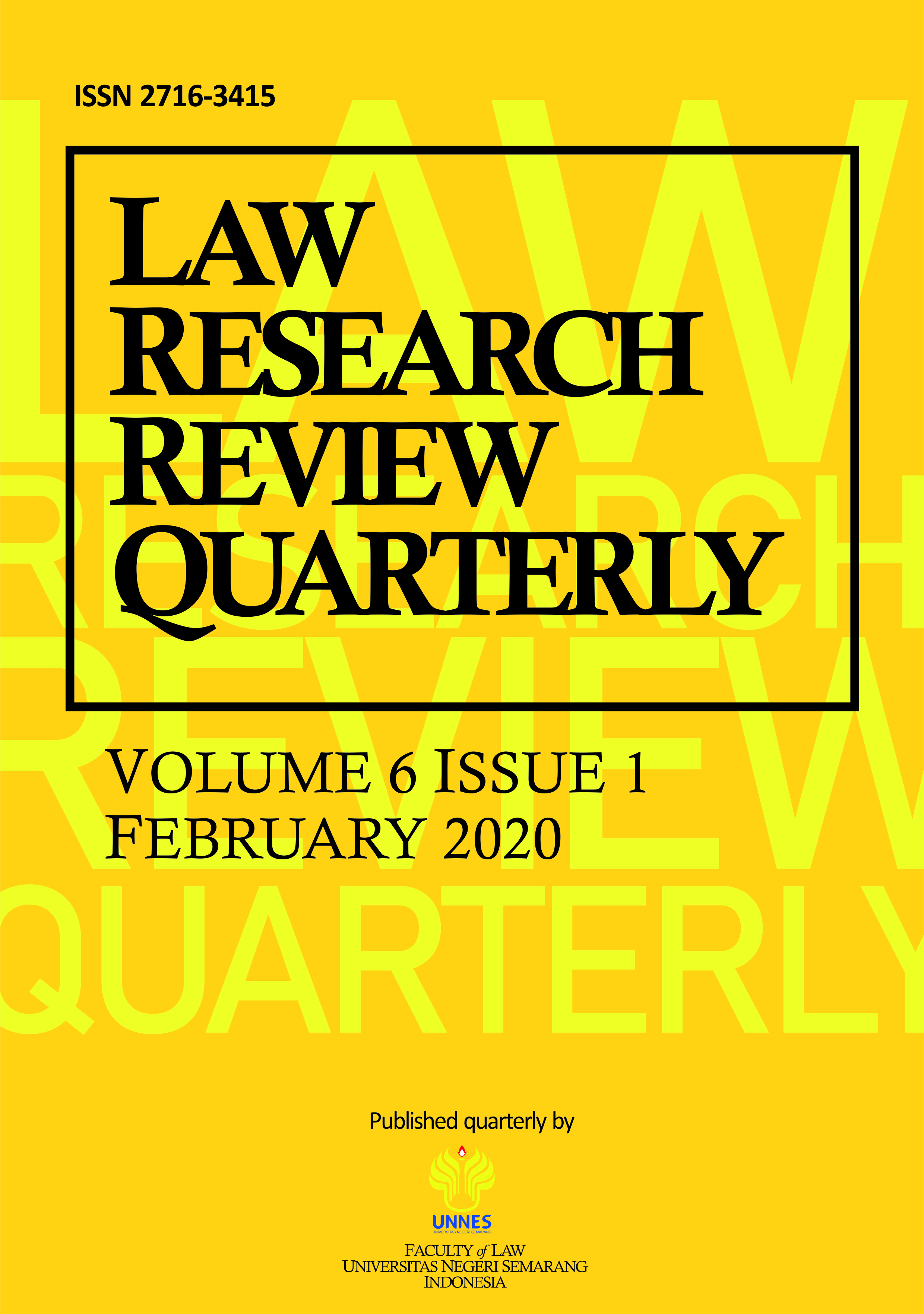Criminological Aspect on Case of Prostitution around Poncol Station Semarang
Main Article Content
Abstract
Prostitution is an anti-social sexual deviation because it violates the norms of decency, norms of decency, customary norms and religious norms. This prostitution occurs in society in the form carried out by a group or individual in an organized manner consisting of pimps, the purpose of getting wages or rewards from those who have used their services. there are two parties namely PSK (Commercial Sex Workers) and masher men as customers. In the Criminal Code (KUHP) only regulates pimps, not yet regulating PSK and its customers. This has an impact on the development of prostitution in people's lives. Prostitution is regulated in Article 296 and Article 506. There are various factors behind the occurrence of this prostitution, such as economic factors caused by economic pressures and life burdens, there are also social factors such as the social environment, and family factors due to divorce or family problems. This study aims to find out what factors underlie the phenomenon of a CSW and analyze based on the perspective of criminological law. This research is located at Semarang Poncol Station on Jalan Imam Bonjol Semarang. This research uses an empirical and qualitative juridical approach. The results of the research and discussion show that the author obtained, among others, can be explained through the formulation that we discussed, namely: The characteristics that exist in the perpetrators of street prostitution, the impact on prostitution, technicalities in transactions between customers and prostitutes, and theories justify the existence of deviations in prostitution.
Article Details
All writings published in this journal are personal views of the authors and do not represent the views of this journal and the author's affiliated institutions. Author(s) are retain the copyrights of the Article. However, before publishing, it is required to obtain written confirmation from Author(s) in order to ensure the originality (Author Statement of Originality). The statement is to be signed by at least one of the authors who have obtained the assent of the co-author(s) where applicable.This work licensed under a Creative Commons Attribution-ShareAlike 4.0 International (CC BY-SA 4.0)
References
Anwa, Yesmil Adang. Pembaharuan Hukum Pidana Reformasi Hukum Pidana. Jakarta: PT Grsindo.
Arifin, R., Waspiah, W., & Latifiani, D. (2018). Penulisan Karya Ilmiah untuk Mahasiswa Hukum. Semarang: BPFH UNNES.
Atmasasmita, Romli. 2005. Teori dan Kapita Selekta Kriminologi. Bandung: Refika Aditama.
Bagong, Suyanto. 2012. Anak Perempuan Yang Dilacurkan, Korban Eksploitasi di Industri Seksual Komersial. Graha Ilmu, Jogjakarta.
Budyn-Kulik, Magdalena. 2018. Violence in Criminology- the Nature, Reasons and Perspective. “ANNALES Universitis Mariae Curieâ€. Vol.LXV No.1
Dirdjosisworo, Soedjono. 2002. Sinopsos Kriminologi Indonesia. Bandung: Mandar Maju.
Dwi Kristian, Ni Made. Kejahatan Kekerasan Seksual (Perkosaan) Ditinjau Dari Perspektif Kriminologi . “Junal Magister Hukum Udayanaâ€. Vol 7 No. 3 2014
Edlund, L., & Korn, E. 2002. A Theory of Prostitution. Jurnal of Political Economy. Vol. 110 No. 1.
Hamzah, Andi. 2008. KUHP dan KUHAP Edisi Revisi 2008. Rineka Cipta. Jakarta.
Imam, Asyari Sapari. 1986. Patologi Sosial. Surabaya: Usaha Nasional.
Indarto. 2015. Identifikasi Problematika Pelacuran Dalam Prespektif Hukum. Vol. 6 No. 4.
Jarvinen, M. 1993. Prostitution in Helsinki: A Disappearing Social Problem? Jurnal of the History Sexuality. Vol. 3 No. 4.
Kartono, Kartini. 1981, Patologi Sosial Jilid 1, Bandung. PT Raja Grafindo.
Lucas, Ann M. 1995. Race, Class, Gender and Deviancy: The Criminalization of Prostitution, Vol. 10 BERKELEY WOMEN’S L.J. 47.
Marzuki. 2002. Metodologi Riset. Yogyakarta: PT Prasetia Widya Pratama.
Matahari, Ratu. 2012. Studi Kualitatif Mengenai Persepsi dan Perilaku Seksual Wanita Pekerja Seks Komersial (PSK ) Dalam Upaya Pencegahan IMS di Kota Semarang Tahun 2012. Jurnal Kesehatan Reproduksi Vol. 3 No. 3 Desember 2012
Moeljatno. 2008. Kitab Undang-Undang Hukum Pidana. Jakarta: Bumi Akasara.
Norrie, Alan. 2017. Criminal Law and Ethics: Beyond Normative Assertion and its Crtique. “The Modern Law Reviewâ€. Vol 80. No. 5
Rahmah, Hilda , Rina Iswari dan Kuncoro Bayu Prasetyo. 2016. Pemanfaatan Jaminan Sosial Kesehatan BPJS di Kalangan Wanita Pekerja Seks (Studi Pada Wanita Pekerja Seks di Sunan Kuning Semarang). “Solidarity†. Vol. 5 No. 2
Sayatori, Toto dan Nanang Gozali. 2012. Metode Penelitian Kuantitatif. Bandung: Penerbit Pustaka Setia.
Senthilathiban, K, Modhava Soma Sundaram, R, Karunahidi, S., 1991. Reactions to Wife – Neating; an Opinion Survey Among Students “ Indian Journal of Criminology “. Vol 19 No. 1.
Sevgi O, Aral and Friends. 2003. The Social Organization of Commercial Sex Work in Moscow, Russia, “Sexually Transmitted Diseasesâ€. Vol. 30. No. 1. January 2003.
Simanjuntak, B. 1981. Pengantar Kriminologi dan Patologi social. Bandung: Tarsito.
Siregar, Kondar. 2015, Model Pengaturan Hukum Tentang Pencegahan Tindak Prostitusi Berbasis Masyarakat Adat Dalihan Na Tolu. Medan: Perdana Mitra Indonesia.
Siti Munawaroh. 2010. Pekerja Seks Komersial (PSK) di Wilayah Prambanan, Kabupaten Klaten Jawa Tengah. DIMENSIA. Volume 4. https://journal.uny.ac.id. 16 Mei 2019.
Utari, Indah Sri. 2012. Aliran dan Teori dalam kriminologi. Semarang: SatciptobRahardjo Institute.
Valor-Sagura, Inmaculada, Expósito, Francisca, dan Moya, Miguel. 2011. The Europen Journal of Psychology Applied to Legal Context, Eur. J: psychol appl legal context, Vol. 3 No. 2.
